
albert Chan
EXECUTIVE SUMMARY
Artificial intelligence is presently causing a great deal of excitement in technology and financial circles. Decades of research into artificial intelligence and neural networks have finally created breakthroughs that can be used in systems that can analyze data and make predictions. These breakthroughs have resulted in stunning amounts being paid to acquire AI companies and invest in startups. At the same time, the excitement over AI has created buzzwords such as “deep learning” and “neural networks,” but they are really just ways to analyze and identify data within the realm of computer science.
To develop these approaches, scientists and programmers have turned to the mysterious human brain and the trillion neurons inside it that transmit and process information, as the model for analyzing data. They have developed networks of cells that mimic the function of neurons. Although this approach has gained and lost favor over time among computer scientists it is currently considered the best approach to accurately and productively identify patterns. Patterns are extremely important in AI; images of handwritten objects or obstacles in the path of a moving autonomous vehicle are patterns that need to be identified and handled.
Although the artificial-intelligence industry is estimated at a mere $400 million in its current infant state, the market could encompass tens of billions of dollars as adjacent industries such as autonomous cars, robots, military, medicine and consumer electronics embrace the technology. As mentioned above, technology that can identify obstacles in the road is extremely important to firms who offer and guarantee a safe ride in an autonomous vehicle. Industrial and technology companies around the globe are aggressively pursuing this potentially important and huge market. The recent advances in AI combined with the potentially large markets that could be enhanced by artificial intelligence, are the likely reason for the avalanche in funding of AI startups and the bidding wars that have occurred to acquire them.
The good news for us humans is neural nets and deep learning have the potential to improve our lives. We already use them every day when we read a BuzzFeed article or look up a room on Airbnb. These two technologies are purely methods for analyzing data and do not appear to lead to computers that become autonomous and self-aware, the stuff of many frightening science-fiction stories.
INTRODUCTION
Neural nets are tools that can be created with electronics or software to emulate some of the function of a neuron, which comprise the human brain.
The human brain is comprised of 1 quadrillion neurons that communicate with each other. As in the human brain, many artificial neurons can be combined in a network to communicate with each other. Deep learning refers to the use of multiple layers of neural networks in order to increase accuracy and productivity.
Specifically, neural nets are good at identifying patterns—in images, speech, data, or even stock prices. The neurons contain programmable elements that are used to evaluate their inputs, and since the parameters contained within these neurons can be changed or tuned to make the pattern identification more accurate, the network “learns” to identify those images.
One application of neural nets is handwriting recognition. In this case, a neural net is fed a sequence of handwritten digits, and the weights are tuned until the network can recognize the digits with acceptable accuracy. The Mixed National Institute of Standards and Technology (MNIST) established a database of 60,000 training digits and 10,000 testing images for tuning and testing handwriting recognition systems. Some of the MNIST digits are included in the figure below.
Figure 1. MNIST Testing/Training Digits
[caption id="attachment_122808" align="aligncenter" width="350"] Source: neuralnetworksanddeeplearning.com[/caption]
Source: neuralnetworksanddeeplearning.com[/caption]
Neural nets date back to the 1940s, when neurophysiologist Warren McCulloch and mathematician Walter Pitts published a paper that described how electrical circuits could be used to create a neural network. In the 1960s, the interest of computer scientists turned to von Neumann architectures that are based on a CPU, logic and memory, and interest in neural nets waned. However, in the 1980s, some groundbreaking developments in neural nets reinvigorated interest, which continues through the present day. Many researchers consider deep learning “the most accurate and productive technique in AI research today,” according to CB Insights.
There are deep learning and machine learning in products and services we consume and use every day, including:
- Product recommendations from Amazon
- Headlines from BuzzFeed
- Prices on the Airbnb website
- Facebook’s M assistant
Google has integrated a deep-learning machine with its Street View platform to enable the identification of nearly every location, and the company is also using its own DeepMind AI technology to reduce the energy used to cool its data center by 40%.
ARTIFICIAL INTELLIGENCE AND NEURAL NETWORKS
Artificial intelligence (AI) refers to the branch of computer science that uses computers to apply human intelligence to solve problems. Within AI, machine learning refers to the techniques used to perform cognitive functions. Deep learning refers to the use of multiple layers of neural networks. The relationship among the three is shown in the Venn diagram below.
Figure 2. Hierarchy and Interaction of Artificial Intelligence Approaches
[caption id="attachment_122809" align="aligncenter" width="300"]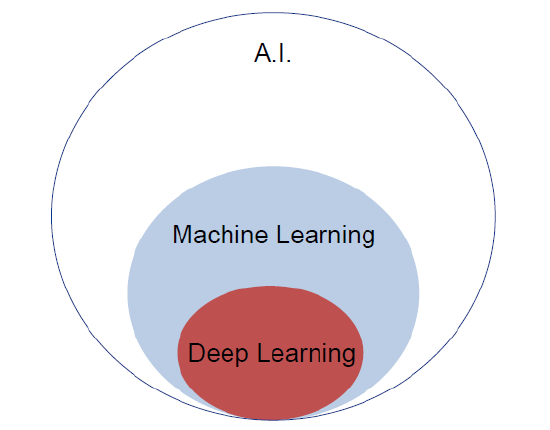 Source: CB Insights[/caption]
Source: CB Insights[/caption]
Deep learning is just one way to create machine learning. Others include:
- Association Rule
- Bayesian
- Clustering
- Decision Trees
- Dimensionality Reduction
- Ensemble
- Instance-based
- Others
- Regression
- Regularization
NEURAL NETWORKS
The human brain is composed of about 100 billion brain cells, or neurons, and each neuron can connect to 10,000 other neurons. Thus, a human brain can contain 1 quadrillion, i.e., 1,000 trillion, synaptic connections. A neuron is illustrated below.
Figure 3. Illustration of a Neuron
[caption id="attachment_122810" align="aligncenter" width="550"]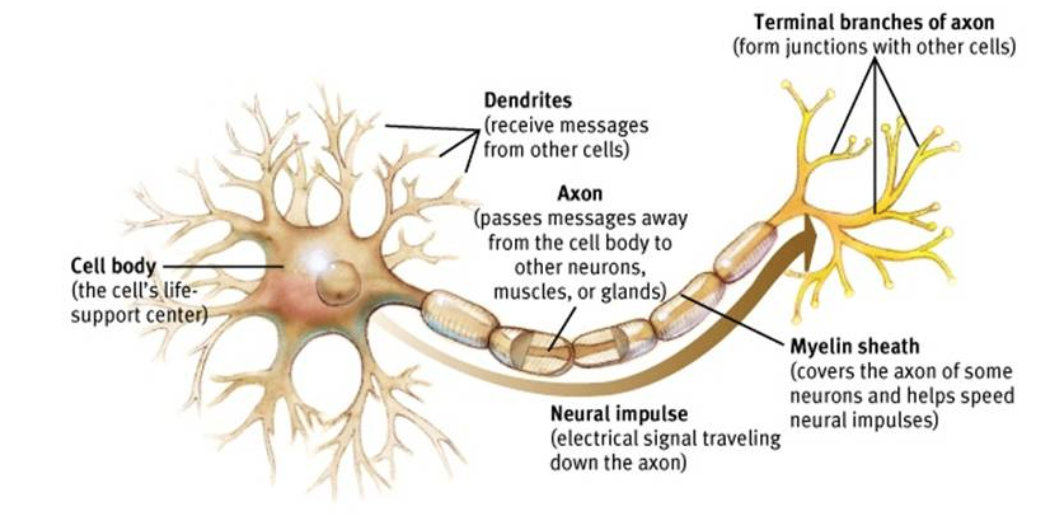 Source: appsychology.com[/caption]
Source: appsychology.com[/caption]
An artificial neuron, or perceptron, works much the same way as a human neuron, with inputs and outputs, and its functional diagram appears similar to a neuron. Several inputs connect to a neuron, which can be implemented in electronics or in software. The electronic device or software contains an algorithm that uses a mathematical function to create a result, which is sent to the output.
The figure below illustrates an artificial neuron in which the output is the sum of each of the inputs, multiplied by a weighting factor via the objective function. The result is considered a one or zero, depending on whether the output exceeds a certain threshold value. Neurons can also use nonlinear and more complex mathematical functions.
Figure 4. Diagram of an Artificial Neuron
[caption id="attachment_122811" align="aligncenter" width="550"] Source: Infinitemusings.com/Fung Global Retail & Technology[/caption]
Source: Infinitemusings.com/Fung Global Retail & Technology[/caption]
DEEP-LEARNING NEURAL NETWORKS
Deep learning is not a machine-learning approach in itself, but rather refers to the use of multiple layers of processing. Deep neural networks have two or more hidden layers, as depicted in the figure below.
Figure 5. Deep Neural Network
[caption id="attachment_122812" align="aligncenter" width="550"] ource: neuralnetworksanddeeplearning.com[/caption]
ource: neuralnetworksanddeeplearning.com[/caption]
APPLICATIONS
Applications for neural nets and deep learning center on image recognition and processing, however the networks can be applied to any data or information that contains patterns. Examples include:
- Computer vision
- Data mining
- Image processing/compression
- Natural-language processing
- Character/pattern recognition
- Robotics
- Stock-market prediction
Other applications continue to be discovered, such as in medicine, identifying odors, security and law enforcement and loan qualification.
Image processing and identification is a very hot topic these days, since many companies in the industrial, automotive, and technology sectors are racing to develop autonomous vehicles, i.e., self-driving cars, that can identify and avoid typical and unforeseen obstacles on the road.
APPLICATION IN AUTONOMOUS VEHICLES/SELF-DRIVING CARS
Self-driving cars need advanced image-processing and identification platforms in order to navigate around and avoid objects and impediments on the road.
In addition to Tesla’s and the work of major automobile manufacturers, many global industrial, technology and software companies are pursuing the development of self-driving cars and researching deep learning.
- There are numerous reports that detail Apple’s research and efforts to develop an autonomous vehicle.
- Google is developing autonomous vehicles and documenting tests near its Silicon Valley headquarters on its blog.
- Chip companies such as NVIDIA and Qualcomm are developing machine-vision chips for use in autonomous vehicles.
Chinese technology giants are also aggressively pursuing the introduction of self-driving cars:
- Online marketplace Alibaba launched a venture with Chinese carmaker SAIC to develop Internet-enabled cars. Management commented they can quickly develop self-driving cars from the platform.
- Chinese web portal Baidu has tested a self-driving car on the roads of Beijing.
- Tencent announced a partnership with Taiwan’s Foxconn and a Chinese luxury auto dealer to explore opportunities in developing smart electric vehicles.
- Carmaker Chongqing Changan Automobile Co. launched a self-driving car that uses cameras and radar. The vehicle completed a 1,200-mile trip in April 2016.
MARKETS
Although the market for artificial intelligence is estimated to be fairly small this year, just $400 million, market researchers expect revenues to grow at a healthy 50%+ rate, and surpass $10 billion in 2024, as illustrated in the graph below.
Figure 6. Artificial Intelligence Revenue (USD Mil.)
[caption id="attachment_122813" align="aligncenter" width="700"]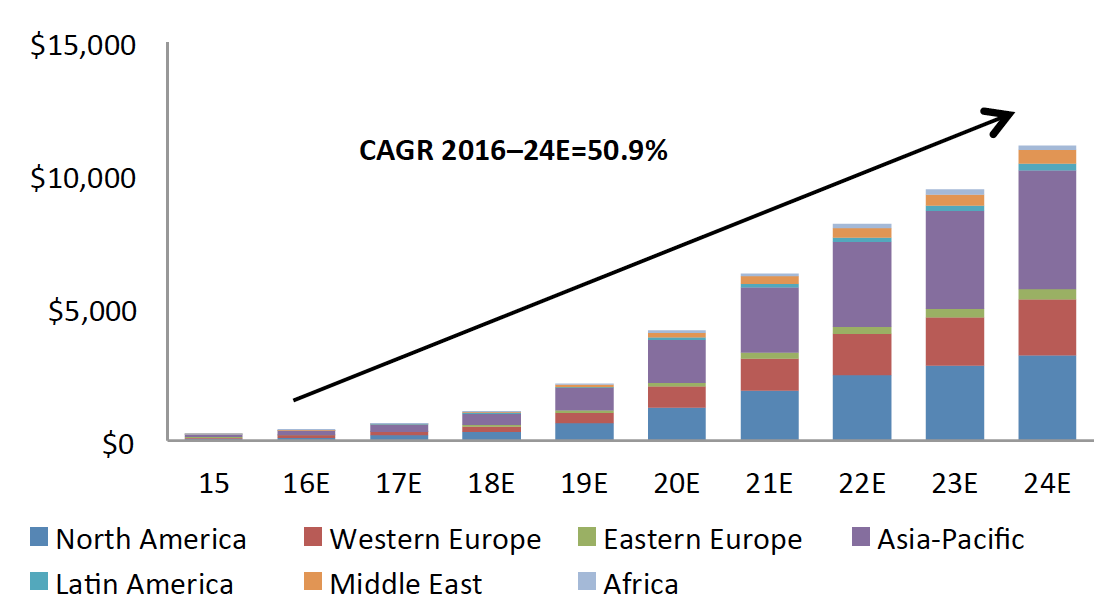 Source: Tractica[/caption]
Source: Tractica[/caption]
In the above graph, we see the Asia-Pacific region is forecasted to pass North America in market size in 2019.
There are several adjacent markets that can benefit from artificial intelligence, including robotics, autonomous cars, unmanned aerial vehicles and healthcare, as depicted in the figure below.
Figure 7. Selected Related AI Markets in 2020 (USD Bil.)
[caption id="attachment_122814" align="aligncenter" width="700"]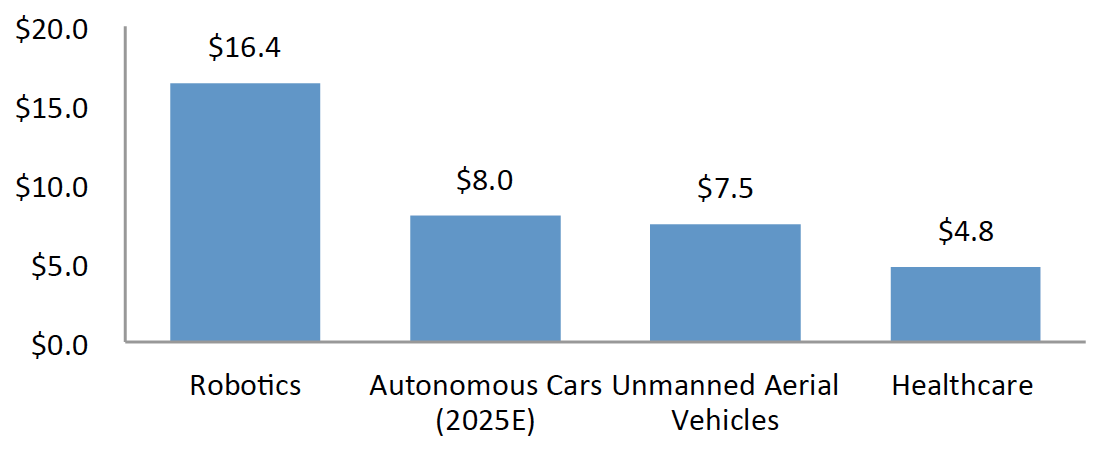 Source: Boston Consulting Group/Company reports/euRobotics/Frost & Sullivan/IHS Automotive/International Federation of Robotics/Japan Robot Association/Ministry of Economy, Trade and Industry/Teal Group/Fung Global Retail & Technology[/caption]
Source: Boston Consulting Group/Company reports/euRobotics/Frost & Sullivan/IHS Automotive/International Federation of Robotics/Japan Robot Association/Ministry of Economy, Trade and Industry/Teal Group/Fung Global Retail & Technology[/caption]
STARTUPS, ACQUISITIONS AND VENTURE-CAPITAL FUNDING
Startups
The potential and power of deep learning has created several startups that develop applications. During the past five years, large technology companies have aggressively acquired them. At the same time, venture-capital financing has flooded into the industry at a rapid rate.
Several innovative private companies are outlined in the table below.
Figure 8. Selected Private Machine-Learning Companies (USD Mil.)
[caption id="attachment_122815" align="aligncenter" width="550"]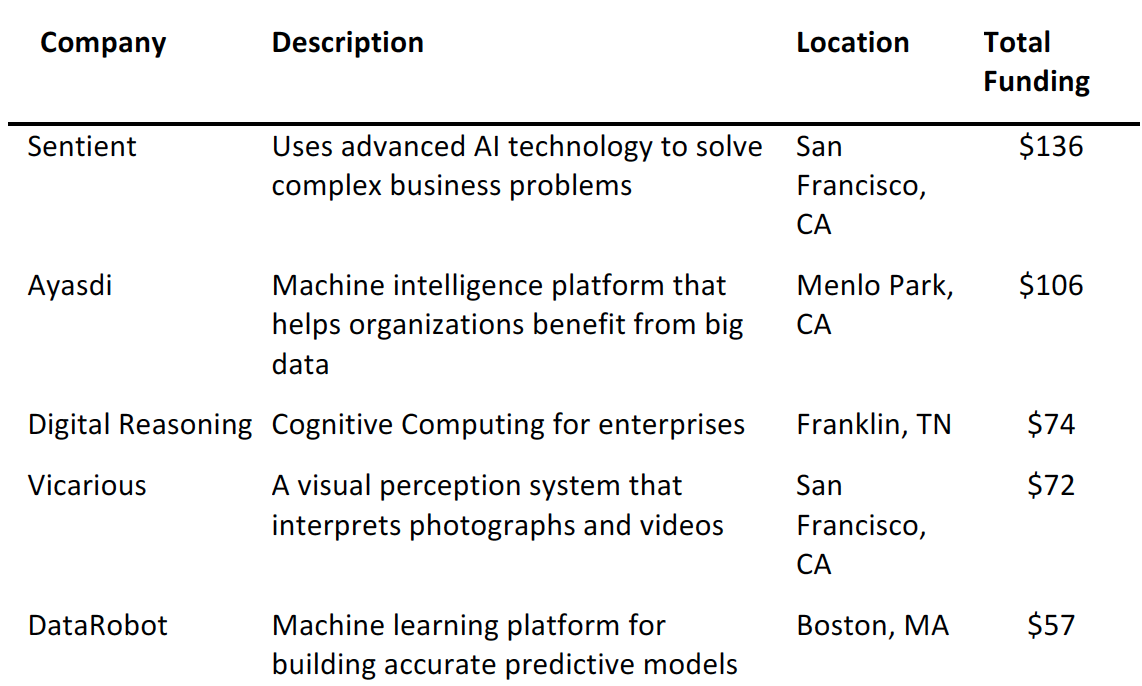 Source: CB Insights/Companies[/caption]
Source: CB Insights/Companies[/caption]
Acquisitions
There has been an explosion in the acquisition of machine-learning and deep-learning companies by large companies, totaling 31 acquisitions since 2011, according to CB Insights. The table below lists selected acquisitions from that list.
Figure 9. Recent Machine Learning Acquisitions
[caption id="attachment_122817" align="aligncenter" width="550"]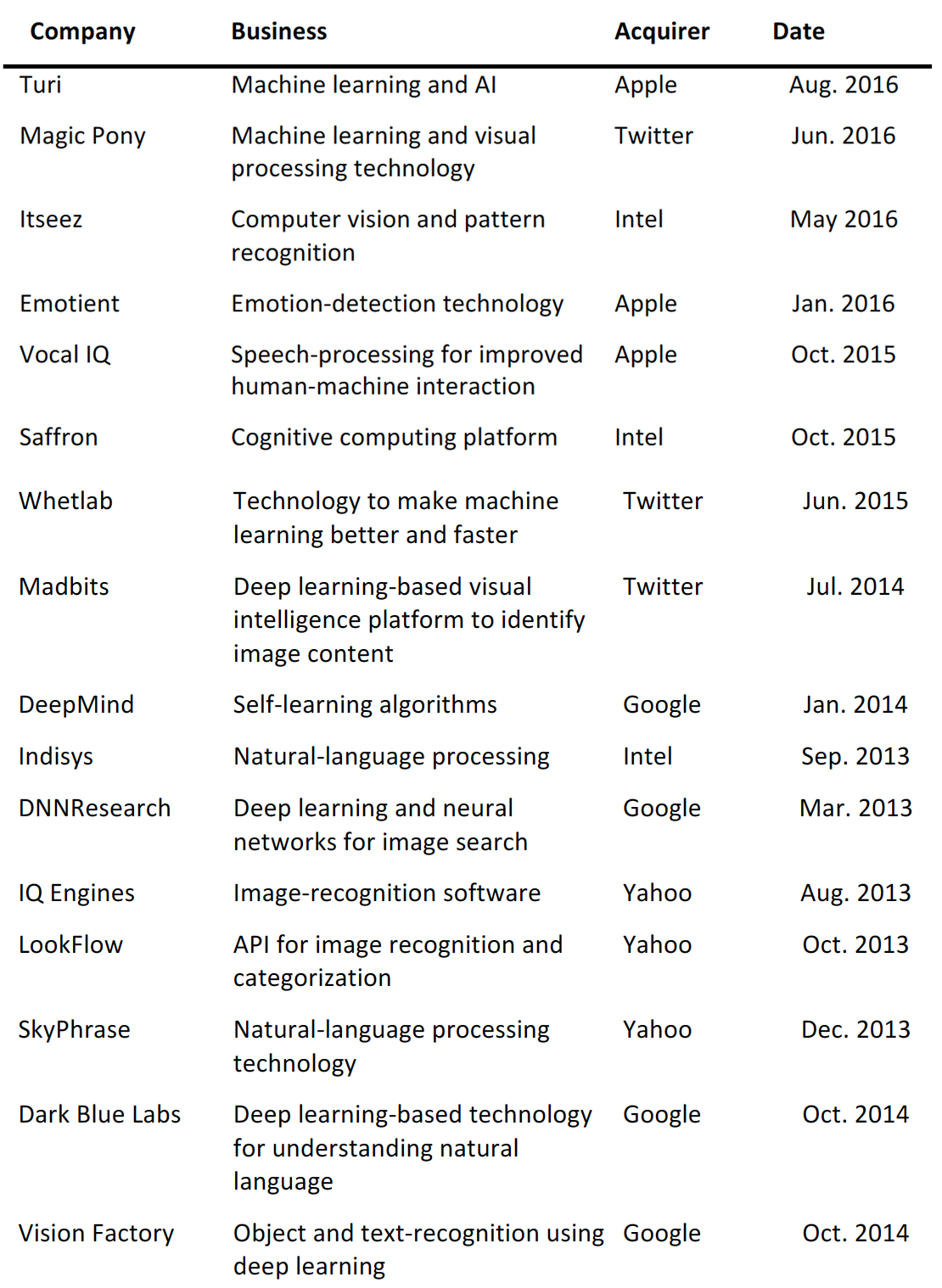 Source: CB Insights/Companies[/caption]
Source: CB Insights/Companies[/caption]
Venture-Capital Funding
Venture-capital funding on artificial intelligence nearly doubled in 2013 and nearly tripled in 2014, according to CB Insights. The amount of funds raised and deals completed increased further in 2015, as depicted in the figure below.
Figure 10. Global Artificial-Intelligence VC Financing (USD Mil.)
[caption id="attachment_122818" align="aligncenter" width="700"] Source: CB Insights[/caption]
Source: CB Insights[/caption]
CONCLUSION
Although deep learning and neural networks are technology buzzwords today, they comprise real products and services we use on a daily basis. Deep learning and neural networks use software to mimic how neurons function in the human brain. They are particularly good at pattern recognition and image processing because they learn when their function is modified. These technologies will likely enable many global markets, particularly autonomous cars. Many global industrial and technology giants are aggressively researching artificial intelligence. This coincides with an investment and acquisition boom in AI startups.